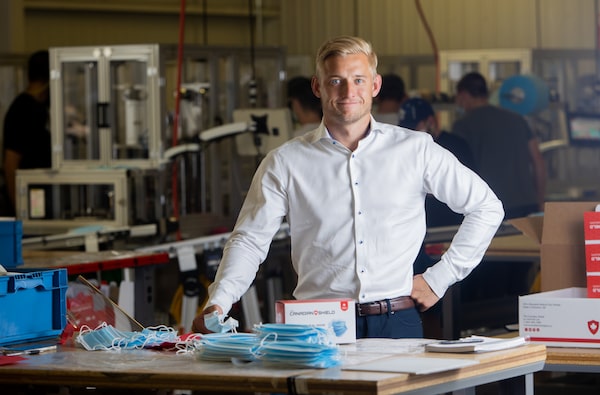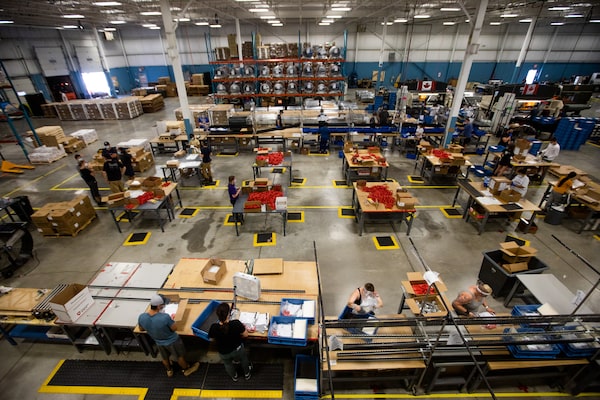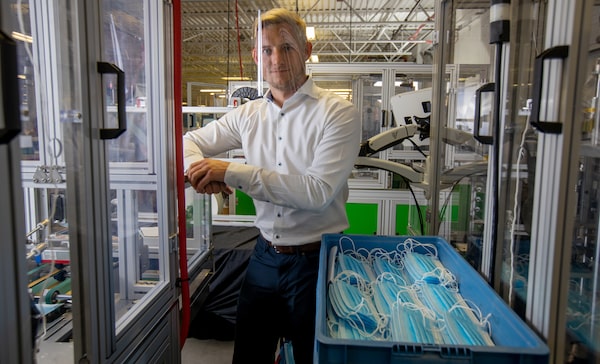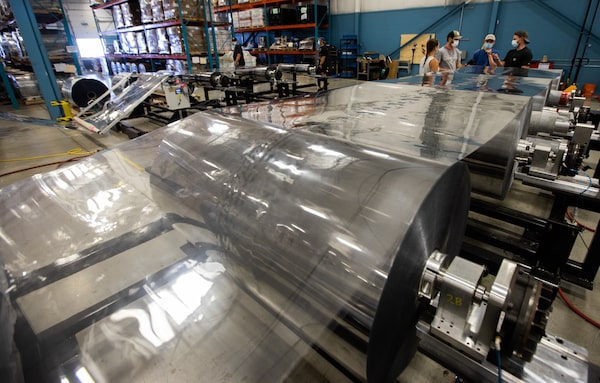
Jeremy Hedges, CEO of InkSmith and The Canadian Shield in Waterloo, is seen on the company’s production floor on Aug. 12, 2020.Glenn Lowson/The Globe and Mail
Since the start of the novel coronavirus pandemic, Kitchener, Ont.-based education technology product maker InkSmith has made one “major transition” after another.
First, InkSmith, which makes 3-D printers, laser cutters, virtual reality headsets and robotic kits for educational uses, saw business decline as schools closed across Canada due to COVID-19. It also watched as the manufacturing plants in China that made its products shut down as the pandemic spread.
Then, being made aware of the need for made-in-Canada personal protective equipment, it started a new company, The Canadian Shield, making face shields and surgical masks. The 10-person company hired 300 employees in four months, became manufacturing experts, and leased a new 50,000-square-foot facility sight unseen.
“All you can do is laugh because it’s that insane,” says Jeremy Hedges, founder and president of InkSmith and The Canadian Shield.
Now, the company is taking this new manufacturing expertise and applying it to its original InkSmith business and bringing the manufacturing of its educational technology products back home instead of having them made overseas.

Canadian Shield with its medical masks and shields finds itself situated in perfect business position as the demand for protection continues to grow.Glenn Lowson/The Globe and Mail
“With everything that’s happened with The Canadian Shield, we are going to onshore all that production [for InkSmith],” Mr. Hedges says.
InkSmith will assemble its 3-D printers and manufacture its robotics kits in Canada starting this fall.
“That’s a pretty major transition for us and it’s pretty exciting,” he says.
The rapid shifts at the company since March are “hard to believe,” adds chief technology officer Doug Braden. “It was surreal to say the least.”
The company saw the lack of personal protective equipment (PPE) in Canada as a “crisis” and thought that it could help, Mr. Braden explains.

Both Hedges businesses focus heavily on their use of technology to increase quality and production.Glenn Lowson/The Globe and Mail
In late March, Dr. Neil Naik with the Kitchener-Waterloo Academy of Medicine came to InkSmith and told Mr. Hedges about the shortage of PPE that would face the region, Ontario and Canada over the next few weeks. He suggested the company use its laser cutters and 3-D printers to make face shields.
“We had a huge stock of machines that we could just unbox, toss on tables and start going,” says Mr. Hedges, and within hours they turned InkSmith’s 5,000 square foot office into a “micro factory” making face shields.
The plan was to donate as much as they could to local hospitals. But it took an hour to 3-D print the headband and only 30 seconds to cut the plastic shield with the laser cutter.

Glenn Lowson/The Globe and Mail
“It was the definition of not scalable,” Mr. Braden says. However, “we knew we could figure this problem out.”
Mr. Hedges and his staff worked on a fully laser cut design while calling on the community to 3-D print headbands, which resulted in 20,000 face shields being donated locally.
The company quickly received its Medical Device Establishment Licence, which made it a legal manufacturer of face shields and it immediately received an order for 350,000 face shields from Ontario. Knowing the company needed to ramp up production, it bought five clicker die-cutting machines that could punch out several plastic shields at once – and bought 12 more once they saw they worked.
“We went from making 100 shields a day to 10,000 shields a day within six days,” Mr. Hedges says. “It’s an old school technology… we just kind of repurposed it to meet this crazy need.”
Within about a month, The Canadian Shield had orders for at least 11.5 million face shields from hospitals, the Ontario and federal governments, Mr. Hedges says. “But it also meant we had to scale up enormously.” By then it was churning out 100,000 face shields per day.
So, the company leased a 50,000-square-foot facility, brought in more machines, including computer-controlled pneumatic die cutters and travelling head presses, started hiring staff and punching out more and more shields every day. “We had to modify [the designs] on the fly,” Mr. Braden says.

Mr. Hedges says because of their background in tech and robotics, the team quickly tried more than a hundred prototypes to find the most effective way to make face shields.Glenn Lowson/The Globe and Mail
That boosted production to at least 200,000 shields a day. “That’s what we can pack and ship out the door,” Mr. Hedges says. Although, in one day, the company made 257,000 shields, “which is kind of nuts,” adds Mr. Braden, considering only weeks before it had made none.
With a background in tech and robotics, the team quickly tried more than a hundred prototypes to find the most effective way to make face shields, he says. It was also able to hire people with the right manufacturing, supply chain or engineering experience who were out of work due to the pandemic, Mr. Braden adds.
“In some ways, The Canadian Shield is the ultimate use case for how design thinking works in action,” Mr. Hedges says.
This experience means InkSmith now has the capability to manufacture its products in the country.
“We have this huge labour force and entity that we can now turn to manufacturing [InkSmith’s] original products here in Canada. Something I always dreamed of doing was bringing our production here to Waterloo and we’re going to do that this fall,” he says.
Everything is getting set up now and InkSmith, with the help of a local manufacturer that has excess time on its production line, will make printed circuit boards for its robotics kits and 3-D printers in Waterloo. As well, InkSmith is looking at purchasing its own circuit board production line – called an SMT or surface mount technology machine – from a local company.

When it started, Canadian Shield went from making 100 shields a day to 10,000 shields a day within six days.Glenn Lowson/The Globe and Mail
“It can all be done here,” Mr. Hedges says.
By taking this new expertise and bringing InkSmith’s electronics manufacturing back to Canada “we’re hopefully turning a new page,” Mr. Hedge says. “That’s what we’re going to get out of this pandemic. I think we’re going to see this huge push at the government level to have products made in Canada.”
He says Canada is not that far behind in manufacturing and with automation – where machines make most items – it can be cost effective to make products here.
The pandemic highlighted “the fragility of international supply chains,” says Mr. Braden, and he’s seen some of startups fold because their production offshore shut down.

Mr. Hedges is hopeful that there'll be a huge push at the government level to have products made in Canada.Glenn Lowson/The Globe and Mail
Bringing manufacturing back to Canada from China “is difficult but it’s not impossible,” says Dan Breznitz, the Munk Chair of Innovation Studies at the University of Toronto. “It is feasible, it should be done but it’s a systemic problem of the whole system.” It’s also a promising way to help boost job creation in Canada at a time where many are out of work.
The key is for a company to have people with the right skills to manufacture goods efficiently to keep costs contained, and have access to the right people to maintain the production lines and the suppliers to keep the company supplied with raw products, Mr. Breznitz says.
“I highly urge our governments at both the federal and provincial level to seize this opportunity and make it happen,” he says, because it takes an entire supply and manufacturing chain to make it successful.
“If COVID-19 taught us just one thing is that we have to rely on ourselves a little bit more … in times of crisis,” he says.